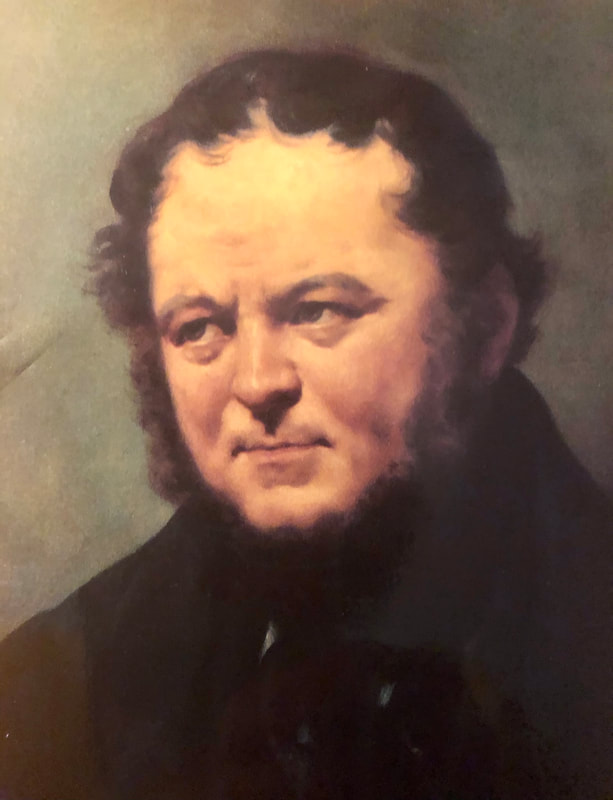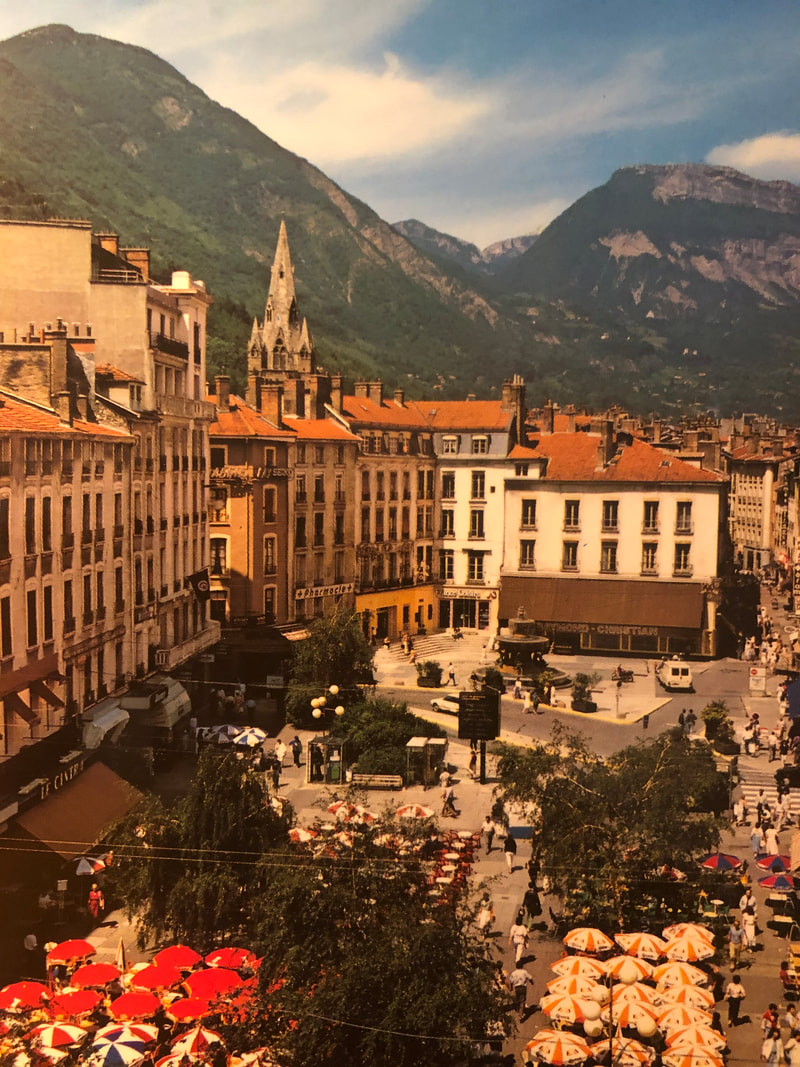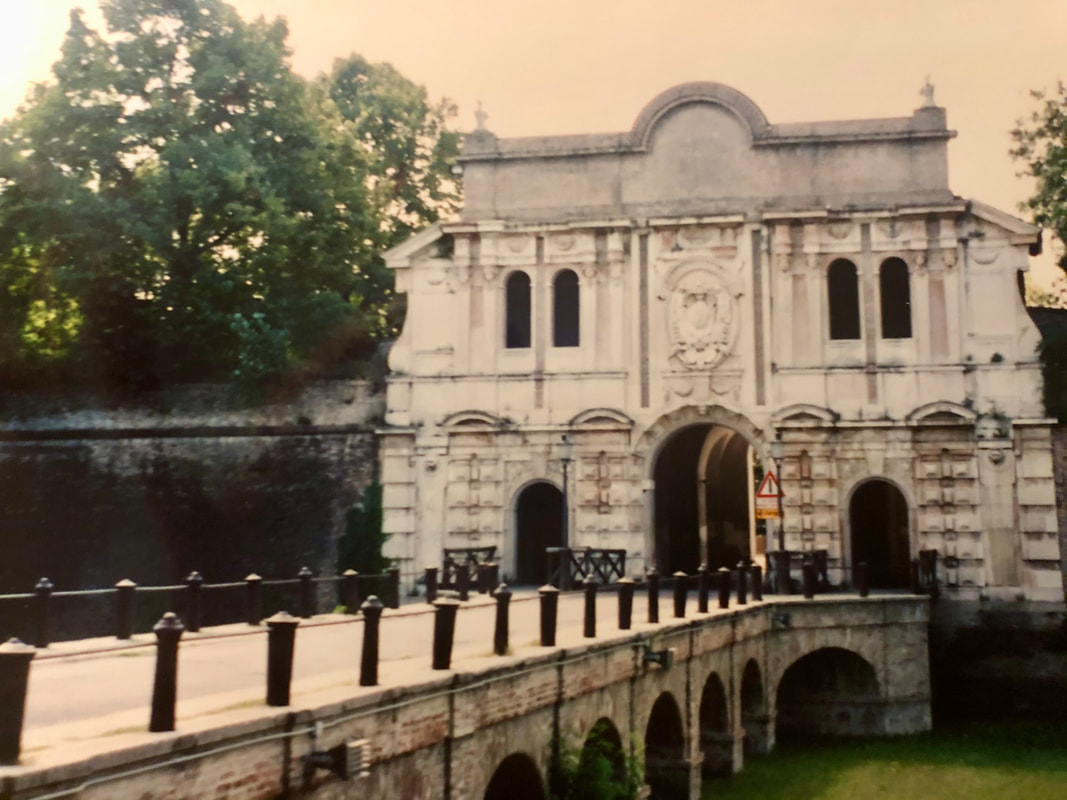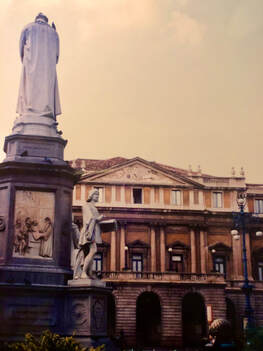|
Traveling With Stendhal
By Christie Seeley vallartasounds.com Marie Henri Beyle is known to the literary world as Stendhal. My infatuation with Stendhal, a native of Grenoble France, began with a course in Romantic French Literature at UC Berkeley. The professor credited him with the quote: "If you have a heart and have a shirt, sell your shirt and go to Italy." those words struck a chord in me. One Spring, when re-reading Stendhal's The Charterhouse of Parma, I decided to make the investigation into his life a good excuse to visit two areas I had long wished to experience, the Dauphine of the Alps of France and the rich Emilia Romagna region of Italy. An ambitious itinerary would take my companion and me to Paris, where Stendhal spent much of his adult life and on to Grenoble, where he was born and raised. From Grenoble, we would take a route through the Swiss Alps into Italy. Both young Stendhal and his "alter ego" Fabrizio, the hero of The Charterhouse of Parma, traveled this route at around age 17. Stendhal was on his way to join his cousin with Napoleon's army, and Fabrizio, a romantic runaway, was returning from Napoleon's fateful battle of Waterloo. Once in Italy we would explore sites important to both young men, including Lago Maggiore, Novara and Alessandria, the location of the famous battle of Marengo. We would continue on to Parma, where Stendhal situated his novel The Charterhouse of Parma and, finalize our trip in his favorite city, Milan. How you gonna keep him down on the farm after he’s seen Paris? Stendhal traveled to Paris in 1799 at age 17, just as Napoleon proclaimed himself first consul. His purpose was to study mathematics at the Ecole Polytechnique. Stendhal's happy childhood in Grenoble had ended upon his mother's death when he was only seven. From that time on, his consuming desire was to rid himself of all that reminded him of this tremendous loss. His diligence in studying mathematics had the goal of his eventual escape from what had become to him a hostile environment. His first lodgings in Paris were in a hotel on the corner of Rue de Bourgogne and Rue Saint Dominique, chosen for its proximity to the Ecole Polytechnique. Deciding against taking the entrance exams, Henri never attended the famous Ecole. Instead, he roamed about exploring his new freedom until he became seriously ill and had to be rescued from his indirection by a wealthy, retired uncle from his mother's side of the family, Noel Daru. Young Henri Beyle moved to the elegant Daru family home on Rue de Lille and Rue de Bellechasse (near the site of the Gare d'Orsay built later in the 19th century). Pierre Daru, the cousin, immediately procured him a position with the War Department, which would determine his career throughout Napoleon's regime. The impressive Domed Church of the old military hospital established by Louis XVI--Les Invalides, stands only a few blocks away from the Daru’s residence at the west end of the 7th arrondissement. There lie the remains of Napoleon I, transported from the place of his death, St. Helena, to this site in 1861. The luxury of the gilded dome of the church offered us a magnificent setting to contemplate the importance of this controversial figure to Stendhal's generation of Europeans. To Stendhal (his pen name taken from a city in Germany where he was stationed in the military), the youngster, he was a massive inspiration as rumors of the young general's early military achievements raced through Grenoble, spurring the boy's imagination with thoughts of grand deeds in what he considered an otherwise stagnant and dull society. Stendhal, the soldier, accompanied Napoleon on numerous military campaigns such as he later brought to life in his novel, The Charterhouse of Parma. He saw Napoleon in person in full military regalia on several occasions and even claimed to have had a conversation with him that left a lasting impression. He worked throughout his life on two unfinished biographies of Napoleon, Life of Napoleon in 1817, and later in 1828, the Memoirs on Napoleon. When Napoleon fell in 1814, Stendhal found himself without a job and somewhat unemployable. During the first period of his Parisian life (1810-1814), Stendhal spent a good share of his time pursuing his latest passion in the left bank cafes of this and the neighboring Montparnasse area, one of his favorites being Cafe de la Rotonde. Although disillusioned by Paris as an unworldly and relatively impoverished youngster, this more experienced and more affluent Stendhal had developed a love for its cultural stimulation. He had just received an important government position, auditor of the crown's museums, including the Louvre, Fontainebleau and Versailles. His quick wit and clever conversation made him a welcome participant at the fashionable salons, which had survived the upheaval of the Terror. At these soirees, he met the beautiful Madame de Recamier and many other important political and literary figures. Stendhal's first love was the theater. As an adolescent, he lost his heart for the first time to the starlet Virginie Kubley. Two of his most lasting relationships with women were with actresses Melanie Guilbert (1804-5) and Angelina Beyerter (1810-1814). For many years he studied the works of Racine and Shakespeare, working toward a future as a dramatist. The result was the now-famous manifesto published in 1823 on the subject. He also published a Life of Rossini in 1823. The opera and theater often occupied his spare time during his stays in Paris. Stendhal enjoyed such evenings at the Comedie Francaise on Rue Richelieu where crowds gathered for theater, socializing and just plain pleasure which was readilly available. Heading out to where it all began—Grenoble To familiarize ourselves more with the Napoleonic feats that so affected the object of our tour, we made our first stop outside Paris, the Empire Galleries at Versailles. There we found documents, drawings, and engravings, from the Napoleonic period. Besides the impressive "Coronation" by David in the Coronation Room, we wondered at the Battle Gallery's collection of magnificent canvases depicting great French battle scenes by Vernet, Delacroix and Gros. The second-floor galleries contain paintings of both of Napoleon's Italian campaigns, which figure in Stendhal's novel, the Russian campaign where Stendhal was present at the front to witness the burning of Moscow, and Waterloo so realistically portrayed by Stendhal in The Charterhouse of Parma. Stendhal described the crossing of the Alps with Napoleon and his first encounter with enemy fire as a "loss of virginity of the other sort". We could well imagine the ordeal upon seeing these heroic pictorial renditions. Prepared to cover some territory in our comfortable air-conditioned rental car, we drove south to Orleans then west through the lush Loire Valley following the river dotted with chateaux and camping. We meandered through the rich wine country of Burgundy on country roads making a stop at the inspiring medieval church of the Madeleine set high on the hill at Vezelay, commencement point for both pilgrims and crusaders. Heading southeast, we saluted the famous chickens of Bresse-en-Bourg as they grazed (yes, grazed) in the fields and taking the last plunge southward into the foothills of the Alps. We made ourselves at home at the old Abbey Hotel at the lovely resort town of Annecy, buzzing with the festivity of swim-suited vacationers and motor boats on the lake. From there, we would visit Stendhal's birthplace, Grenoble, just one hour away. Grenoble, located at the base of the French Alps at the confluence of the Drac and the Isere rivers, is today an attractive and exciting center of activity and international business. The historic center of medieval and renaissance buildings houses shops and cafes on its pedestrian-only streets. At the Place des Grenelles, always a very active square and gathering place for Grenoble residents, stands the home of Stendhal's maternal grandfather, Dr. Gagnon. Stendhal spent much of his time there following the death of his mother. From the ample windows overlooking the place and its lovely fountain, he watched history develop and formed his interpretation of the world. From his mother's families' Provencal heritage, he derived an open intellect and a lust for adventure--his "espagnolism", to offset the cold, conservative, greedy influence of his father. The Beyle family home, now housing the Resistance museum, is on the narrow and relatively dark adjoining Rue Jean Jacques Rousseau, which used to be called Rue des Vieuxes Jesuits. Significantly, it was in this home that Stendhal was educated by strict, closed-minded Jesuit tutors until finally allowed to attend the public Ecole Centrale, where he read Jean Jacques Rousseau, who was a significant influence on his young mind. According to Stendhal, while his mother was alive, the house seemed warm and bright; her death, however, left the house dark and foreboding. We visited the Musee Stendhal, housed in what in Stendhal's time had been the Town Hall. This historic building looks out on the Jardins de Ville, lined with chestnut trees. The park was important in his childhood memories. He walked triumphantly across these gardens after being presented with the first prize in the mathematics competition that would be his ticket out of Grenoble through a recommendation to the Ecole Polytechnique. In the museum, we mused over first editions of Stendhal's works, letters to intimate friends and his sister Pauline with whom he maintained a continual correspondence sharing his insights and advice, along with paintings and drawings of Stendhal, his family members and close friends. In the Red and the Black opening, Stendhal gives us a clear picture of his feelings for the provincial French town. To the visitor, he tells us, the neat village surrounded by the grandeur of the Alps and the rushing river seems to embody all that is peaceful, clean, healthy and productive. However, when one gets to know the pettiness of the self-important, money-hungry inhabitants, all is changed. These words reflected his opinion of the people of the Dauphine in general and his father specifically, which made Stendhal so dislike Grenoble. Henri Beyle’s Love Affair with Italy Stendhal's first acquaintance with Italy came through his military career. He was sent to Milan in 1800 to join the division of his cousin, Marital Daru. There he discovered people more concerned with the callings of their passions than that of their pocketbooks. In the prologue to The Charterhouse of Parma, Stendhal relates that to the Italians, "...poverty is not...considered a subject for ridicule." He had had sufficient experience to confirm this statement written in 1838. He lived in Italy unemployed after Napoleon's fall in 1814 -1821, and he was French Consul at CittaVecchia in 1838, both periods of his life when he had very limited resources. We passed through Geneva as Stendhal had done, exploring the homeland of his hero Jean Jacques Rousseau. We drove at a leisurely pace along the north shore of Lake Geneva (Lemans to the Swiss), rimmed with vineyards, beautiful landscapes and small, very civilized towns. As we left the lake and headed east, our route took us to the junction for the Saint Bernard tunnel, the pass over which Napoleon led his troops to get to Italy and the Battle of Marengo in 1800. Stendhal took the exact route, wet and cold on horseback, to join those troops in Novara and go on to Milan. Continuing east, we followed the Rhone River, the Alps rising all around us, and crossed the mountains at the Simplon Pass--constructed later by Napoleon to return his troops to Geneva after the Battle of Marengo. Our turbodiesel Lancia ascended 1500 meters in such a short time that it felt like an elevator ride and offered spectacular views of the Rhone Valley below, abundant with vineyards and timbered Swiss Chalets. The summit was active as hikers and sightseers explored the vast alpine meadow. Huts on the mountainside reminiscent of Heidi's were sprinkled here and there. Following crystal, icy-looking rivers, we came out of the mountains on the Italian side through fields of sunflowers. We were soon rewarded by an immensity of blue, which was actually but a slight curve of Lago Maggiore as it opened into a grand bay between the towns of Stresa and Pallanza, showing off the jewel-like Borromean Islands and Island of the Fishermen, Isola dei Pescatori. As we approached Stresa, we were stunned by the impact of the lake, even then only viewing about one-third of its entire area that reaches well into Switzerland at the Northern end. Upon visiting Lago Maggiore in 1800, Stendhal wrote to his sister Pauline that the beauty of Maggiore and the Borromean Islands was unsurpassed even by Lake Geneva. In The Charterhouse of Parma, Fabrizio's mother often maintained a villa on Lago Maggiore. The Duchessa Sanseverina also took an estate on the Swiss end of the lake to hide Fabrizio after he escaped from imprisonment in the Citadel of Parma. We stayed at an old villa which once welcomed 19th-century intellectuals as guests, perhaps even Stendhal near the town of Stresa. The best way to see Lago Maggiore is to catch one of the numerous ferries that transport sightseers to Isola Madre, Isola Bella and Isola dei Pescatori. In the cool morning air on the deck of one of these ferries, we guessed at which of the villas that lined the shore might have been occupied by the beautiful Duchessa Sanseverina in Stendhal's novel. From which dock did she take a boat each day to meet Fabrizio for their long silent rides? Our ferry took us through early morning drizzle to both Isola Madre and Isola Bella. We stopped to appreciate ornate gardens and villas built by the wealthy Milanese Borromeo family in the 17th and 18th centuries, catching the next ferry out again. The smallest of the island group, Isola dei Pescatori, is not one of the Borromean Islands but a tiny independent fishing community. We chose a small terrace restaurant at the far end of the island for lunch. Soon we were joined by some of the island residents--about six in total--ranging from calico to black and white spots to jet-black recognizing that, indeed, a fishermen's island should have more than its share of feline inhabitants. Napoleon and the Battles Early one morning with the mist rising from the lake, we headed south to Novara, where Fabrizio spent his first exile. He was denounced to the Austrian authorities by his brother. Novara is also the town where Stendhal was to hear his first Italian opera, an experience that overwhelmed him with emotion. The country around Novara is rich agricultural land, which leads into the Piedmont wine country extending from Asti to Alba, Monferrato and Acqui Terme to Alessandria. It is a lush, affluent country that boasts of its white truffle the Italians treasure. Just south of Alessandria on the old Genoa Road, we finally located our objective--the village of Marengo and the battlefield where Napoleon defeated the Austrians on his second Italian campaign. The credit for this famous victory goes to General Desaix. Finding Napoleon's troops overcome by those of Austria's Field Marshall Melas at 3:00 in the afternoon on the 14th of June, 1800, he announced, "The battle has been lost, there is still time to win another," and offered to lead the attack in which he won the day but lost his life. Stendhal himself joined the troops at Marengo before heading back to Paris. He boasted of having a face-to-face encounter with Napoleon though he was not involved in the battle. We left these remains of real and fictional events and continued to Genoa along the magnificent Ligurian Coast road offering a unique system of tunnels. We made a stop at La Spezia to appreciate the view of the rugged coastline tucking in and out around five remote seaside towns known together as Cinque Terre and then headed inland to our destination of Parma. Parma and the Drama of the Charterhouse Parma, the location of most of Stendhal's last important novel, is a lively city of yellow-painted facades, the red brick of the Po Valley and pink Verona marble, set in the middle of the rich gold-colored fields of the Emilia Romagna. In Parma, we discovered a city of distinctive medieval and renaissance buildings, including the Palazzo Della Pilotta, built by Ranuncio Farnese, and the Po Valley-Romanesque Cathedral (1092) with its pink Verona marble Baptistry. Of primary interest to us were the remnants of the Citadel, begun by Alessandro Farnese as an exercise in military architecture and completed by his son Ranuncio as a prison. The Citadel was the site of Fabrizio's detention, dramatic escape and eventual surrender due to a treacherous but pure love affair with the daughter of the Governor of the Citadel, Clelia. The site is surrounded by a fashionable residential neighborhood on the front and the countryside at the rear. Its walls and main gate, the cornice of which displays the Farnese coat of arms, are nicely intact. Modern Parmigiani uses the park-like grounds for jogging, cycling and picnicking. The impressively oversized Palazzo Pilotta dominates the old city. Its original purpose was to integrate the various ducal residences and government buildings. The Palazzo still holds some pleasant surprises including the Farnese Theater. Again, Stendhal's love of the theater brought some of the critical action of the novel to theatrical performances performed by the court exclusively for the court's entertainment. There significant political negotiations took place amidst the glamiour of the performances. The double grand staircase and dome of the Palazzo are reflective of the powerful position of the Farnese dukes in Stendhal's story. Departing Parma by the local road toward Mantova, we passed the Charterhouse at Paradigna used as the model for the Charterhouse of Parma of Stendhal's novel. A short distance down the road, we visited Colorno, where the palace described by Stendhal as the Versailles of Parma still stands. Crossing the bridge over the Po a few kilometers away, we could see the glimmering roofs and the dome of the church of the town of Castalmaggiore. We envisioned the San Severino family servant Ludovico hiding Fabrizio in the rushes below as they made their way down the river to safety after his escape from the Citadel. Milan! We wound up our trip with Stendhal's favorite city, Milan. He wrote such things to his sister Pauline throughout his lifetime as "...my heart feels only Milan and the luxuriant countryside around it." Paris had liberated him from his provincial family, but Milan freed him from his inhibitions and allowed him to discover his nature. After falling in love a few times and being expelled by Austrian authorities, he briefly returned to Paris in 1821. Two years later, Stendhal set out again for Italy to travel and write but could never again enter Milan. Still, "It is only in Italy that one cannot help loving." he wrote to Pauline. Finally, he was appointed French Consul to CittaVecchia in 1831, a post not so much to his liking but allowed him time for his writing and traveling whenever he had an excuse. Without ever returning to his beloved city, he succumbed to a lifelong illness in 1842 while seeking medical advice in Paris and was buried there, not in Milan as he had wished. By the end of his life, Stendhal considered himself more Italian than French. One of the most profound effects Italy had on Stendhal was to open his heart to the world of music. On his first trip to Italy, he heard for the first time the themes of Cimarosa. He wrote to his sister of the heavenly sounds and the beauty of the Italian opera. It is not surprising that in The Charterhouse of Parma, Stendhal introduced us to the workings of Milanese society in the recently constructed Teatro Della Scala. According to Stendhal's description both in his novel and his letters, the boxes of La Scala were the center of social activity, where influential individuals "held court," the etiquette of which was strictly defined, though unwritten. Stendhal, as well as his characters, spent many happy hours at La Scala opera house. We approached La Scala walking from the Duomo with its splendid white spires reaching heaven through the elegant glass-covered Galleria. We looked across the piazza, past the statue of Leonardo da Vinci, at the yellow arches of La Scala where the simple, stately facade masks an elegant interior, which is the setting for some of the most impressive performances of opera, music and ballet in the world. We knew that Milan would not have been the same to the Duchessa Sanseverina and the Conte Mosca or Stendhal without La Scala. It was the last night of our trip. Though the city was close to deserted on this mid-August Saturday evening, we were lucky to find open an elegant, neighborhood trattoria near the Porta Genova, the Aurora. In the freshness of a large trellised courtyard, in the company of well-dressed Milanese and perfectly starched waiters, we enjoyed countless courses of antipasti, followed by risotto, veal cutlets, and velvety gelato accompanied by a rich regional red wine. We reminisced over the exquisite meals we had enjoyed, the sights we had seen, and the pure pleasure that travel avails to the adventurous spirit. Stendhal was one who truly understood the joys of travel for the sake of travel. He published a tourist guide to Italy, Rome, Naples and Florence, in 1817, followed by Promenades in Rome in 1829, which enjoyed great success. Throughout his life, he found himself, more often than not, on the road. We take our cues from him and plan our next journey before arriving home from the present—Bon Voyage to us all.
0 Comments
Leave a Reply. |
Christie SeeleyI am a writer who covers film, art, music and culture expanding on my own experience, travels and interests. My goal is to explore and to share, hopefully inspiring my readers to follow my lead and further enrich their lives as well. Archives
March 2024
Categories |




 RSS Feed
RSS Feed